Radiative Blood-Based Hybrid Copper-Graphene Nanoliquid Flows along a Source-Heated Leaning Cylinder
Siti Nur Ainsyah Ghani and Noor Fadiya Mohd Noor,2,★
1Institute of Mathematical Sciences,Faculty of Science,Universiti Malaya,Kuala Lumpur,50603,Malaysia
2Center for Data Analytics Consultancy&Services(UM-CDACS),Faculty of Science,Universiti Malaya,Kuala Lumpur,50603,Malaysia
ABSTRACT Variant graphene,graphene oxides(GO),and graphene nanoplatelets(GNP)dispersed in blood-based copper(Cu)nanoliquids over a leaning permeable cylinder are the focus of this study.These forms of graphene are highly beneficial in the biological and medical fields for cancer therapy,anti-infection measures,and drug delivery.The non-Newtonian Sutterby(blood-based)hybrid nanoliquid flows are generalized within the context of the Tiwari-Das model to simulate the effects of radiation and heating sources.The governing partial differential equations are reformulated into a nonlinear set of ordinary differential equations using similar transformational expressions.These equations are then transformed into boundary value problems through a shooting technique,followed by the implementation of the bvp4c tool in MATLAB.The influences of various parameters on the model’s nondimensional velocity and temperature profiles,reduced skin friction,and reduced Nusselt number are presented for detailed discussions.The results indicated that Cu-GNP/blood and Cu-GO/blood hybrid nanofluids exhibit the lowest and highest velocity distributions,respectively,for increased nanoparticles volume fraction,curvature parameter,Sutterby fluid parameter,Hartmann number,and wall permeability parameter.Conversely,opposite trends are observed for the temperature distribution for all considered parameters,except the mixed convection parameter.Increases in the reduced skin friction magnitude and the reduced Nusselt number with higher values of graphene/GO/GNP nanoparticle volume fraction are also reported.Finally,GNP is identified as the superior heat conductor,with an average increase of approximately 5%and a peak of 7.8%in the reduced Nusselt number compared to graphene and GO nanoparticles in the Cu/blood nanofluids.
KEYWORDS Hybrid nanofluid;sutterby fluid;tiwari-das model;thermal radiation;graphene;graphene oxides;graphene nanoplatelets
Nomenclature
B0External magnetic field(T)
cpSpecific heat capacity(J/kgK)
Hw*Uniform surface mass flux(kg/(m2s))
lReference length(m)
mFlow component index(-)
nNanoparticle shape factor(-)
Q*Source of heating(J)
qwFlux of heat(W/m2)
ReReynolds number(-)
TTemperature(K)
u,vVelocity associated components(m/s)
U0Velocity of free stream(m/s)
Greek Symbols
betaTCoefficient for thermal expansion(1/K)
sigmaElectrical conductivity(S/m)
tauwShear stress(Pa)
φ1Nanoparticles volume fraction for Cu(-)
φ2Nanoparticles volume fraction for graphene/GO/GNP(-)
Subscripts
fBased fluid
nfMono/single nanofluids
hnfDuo/hybrid nanofluids
s1 Cu solid nanoparticles
s2 Graphene/GO/GNP solid nanoparticles
wWall surface of a cylinder
0 Initial or reference
∞ Ambient
1 Introduction
The boundary layer is a fundamental concept in understanding fluid transportation over a surface from theoretical fluid mechanics perspectives,pioneered by Prandtl in 1904[1].Conventional liquids,such as oil,ethylene glycol (EG),and water,used in various mechanical and technical operations,typically exhibit poor thermal conductivity,limiting the heat transfer efficiency for specific engineering processes.In 1993,Choi et al.[2]introduced a nanotechnology-based fluid aimed at enhancing energy efficiency and heat transfer capacity.As a result,nanofluids became prominent in heat transfer applications,including the biomedical and pharmaceutical sectors,microelectronics,magma solidification,cooling and heating exchangers,drug delivery,and food manufacturing.A mono nanofluid is defined as a single type of solid nanoparticle homogeneously dispersed in an ordinary liquid.Recent attention has shifted toward the introduction of multiple different nanoparticles suspended in that ordinary liquid,referred to as hybrid,ternary,or composite nanofluids.These advanced nanofluids integrate the chemical and physical properties of the suspended nanoparticles within a single phase,yielding diverse effects from the combined elements[3].Babu et al.[4]found that hybrid nanomaterials display distinct physicochemical characteristics absent in general fluids or mono nanofluids.This discovery spurred further research on various hybrid nanofluids,examining their preparation,synthesis,and characterization stages.It was reported that thermal conductivity in hybrid nanofluids surpassed that of mono nanofluids [5].In addition,hybrid nanofluids achieved higher heat flux than mono nanofluids in a study of Copper-Alumina/water(Cu-Al2O3/H2O)by Nadeem et al.[6].Salah et al.[7]reported that using the Al-Mg-TiO2/water-ethylene glycol ternary hybrid nanofluid substantially increases the heat transfer coefficient for swirl flow within a rotating cone.
Blood is considered an incompressible flow consisting of the boundary layer flow and the potential flow within arteries.Analyzing blood flow over cylindrical surfaces has crucial applications in diagnosing and treating conditions related to plaque deposition and aneurysms in cardiovascular diseases,minimizing post-operative complications,and reducing healthcare costs.This analysis also applies to tumor treatments,blood clot removals,brain aneurysms,and infections.However,selecting appropriate models and approaches to depict blood flow challenges is vital to ensure realistic and effective solutions.According to Akhtar et al.[8],many researchers preferred non-Newtonian boundary layer models to study arterial blood flows,as these models provide a more accurate representation of hemodynamics.Recent studies have also reported on blood nanofluid boundary layer flows.Akhtar et al.[8] simulated blood flow within a symmetrically stenosed artery using the non-Newtonian Casson model,suggesting that their findings are crucial for surgical considerations,including assessing stenosis shape,location,and formation.McCash et al.[9] numerically explored the entropy analysis of the peristaltic flow of a Cu-Ag/water hybrid nanofluid within an elliptical duct with sinusoidal progressing boundaries.Tripathi et al.[10]presented a theoretical and numerical evaluation of unsteady blood flow in a diseased artery featuring irregular stenosis,focusing on drug delivery applications for blood vessels using an Ag-gold/blood hybrid nanofluid boundary layer model.Sharma et al.[11] examined the impact of the Au-Al2O3/blood hybrid nanoliquid on the hemodynamic properties of unsteady blood flow in a curved artery with stenosis and aneurysm.They concluded that the chosen hybrid nanomaterials can modulate blood velocity and temperature,enabling surgeons to adjust them as required.
Sutterby liquid is crucial in the polymer industry,making it one of the most frequently discussed non-Newtonian fluids due to its rheological features[12].This non-Newtonian fluid model characterizes the behavior of pseudoplastic substances.To date,researchers have presented their findings using both analytical and numerical methods across various geometries to evaluate the heat energy efficiency of non-Newtonian Sutterby hybrid nanofluid flows.Waqas et al.[13]studied SiO2-SWCNT/EG and MoS2-MWCNT/EG hybrid nanofluid boundary layer flows in the three-dimensional Sutterby model over a stretchy surface affected by thermal convection,radiation,and heat melting.They observed that the temperature and velocity profiles decrease when larger melting parameter values are applied.Al-Mughanam et al.[14]numerically examined the characteristics of mono,duo,and tri-nanoparticles suspended in the Sutterby fluid model using the Finite Element Method(FEM).They noted moderate values of thermal memory effects in the hybrid nanofluid compared to other types of nanofluids under consideration.Bouslimi et al.[15]discussed the heat transport efficiency of Sutterby mono and hybrid nanofluid flows past a slippery hot surface,while Jamshed et al.[16]found in their study that Sutterby nanofluids using hybrid Copper-Sodium-Alginate(Cu-SA)and Gold-Sodium-Alginate(Au-SA)nanoparticles enhance the rate of heat transfer in the Parabolic Trough Solar Collector(PSTC).These studies highlight that non-Newtonian Sutterby fluids have found use in various applications,including lubrication and drilling operations.
The importance of nanoliquids by focusing on the solid nanoparticles’volume fraction,where the thermophysical properties of both the base fluid and nanoparticles are heterogeneously correlated,was initially examined by Tiwari et al.[17].Numerous studies on the Tiwari and Das hybrid nanofluid models are now available in the literature.Dinarvand et al.[18]analytically explored the Cu-Ag/water hybrid nanoliquid model developed based on the Tiwari-Das framework near a vertically permeable circular channel.A subsequent study by Dinarvand et al.[19] found that the Tiwari-Das Falkner-Skan model for TiO2-CuO/water hybrid nanofluids outperforms mono-nanofluids regarding heat flux.Additionally,Ramzan et al.[20] utilized the Tiwari-Das model for SiO2-TiO2/water hybrid nanofluid flows through a rotary channel influenced by the Hall current.They indicated that the hybrid nanofluid flow is superior to the performance of mono-nanofluid systems in solar thermal applications.Alwawi et al.[21]developed the Tiwari-Das mathematical model to simulate the behavior of Williamson hybrid nanoliquid flows over a cylinder.They reported that silver-aluminum oxide nanoparticles demonstrate superiority in enhancing the velocity and energy transfer of the base fluid.Furthermore,Saranya et al.[22] examined the thermal behavior of the Blasius-Sakiadis Tiwari-Das flow for water-based ternary hybrid nanofluids,considering the effect of nanoparticle shape.
The attention focused on selecting various types of graphene-based solid nanoparticles for producing single and hybrid nanoliquids offers significant advantages for technological and scientific approaches.Graphene-based nanoparticles provide excellent thermal conductivity and stability and serve as flexible transporters with minimal corrosion and erosion[23].Moreover,because graphenebased materials exhibit superior electrical conductivity,high chemical stability,and exceptional mechanical behavior,they are efficiently utilized in supercapacitors and other energy storage devices[24].Graphene-based materials have also demonstrated vast applicability in the medical field for applications such as cancer therapy and diagnosis,sensing and imaging,tissue regeneration,and drug delivery [25].Mehrali et al.[26] reported that graphene-magnetite hybrid nanoparticles increase the fluid thermal conductivity by approximately 11%.In contrast,Sadeghinezhad et al.[27]observed that graphene nanoparticles offer higher stability and a surface area thousands of times greater than other nanoparticles.Additionally,Purbia et al.[28] reported that the heat flux increases by about 32% at a 0.1% concentration of graphene nanomaterials,attributed to the enhanced thermal conductivity and Reynolds number of the conducting solid nanomaterials.Bouslimi et al.[15]also found that the thermal transmission rate of the Sutterby hybrid Cu-GO/engine oil nanoliquid surpasses that of the mono Cu/engine oil nanoliquid.
Limited studies on the Sutterby liquid model over a cylinder inspired the current research to further investigate the heat flux efficiency of selected hybrid nanofluids.The examination of graphene,graphene oxides (GO),and graphene nanoplatelets (GNP) as potential nanomaterials in fluid mechanics remains infrequent despite their exceptional combination of mechanical and electrical properties.This research is the first to analyze graphene,GO,and GNP nanoparticles dispersed in the radiative Cu/blood mono nanofluid to form various hybrid mixtures around a slanted permeable cylinder in the existing literature.The impacts of thermal radiation and the heat source are also considered in this study.MATLAB’s bvp4c code is utilized to address the transformed boundary value problems derived from the primary set of partial differential equations(PDEs).Comprehensive results are validated and compared,and the effects of specific parameters on the hybrid Sutterby non-Newtonian nanofluids in terms of non-dimensional velocity and temperature distributions,reduced skin friction value,and reduced Nusselt number are thoroughly investigated.The findings are then presented in tables and graphs in the final section of this research.
Accordingly,the contributions of this research are outlined as follows:
1.This study represents the first exploration of the non-Newtonian Sutterby Tiwari-Das model using blood as the base fluid with hybrid nanoparticles,while previous research focused on other conventional base fluids[15,16].
2.The dispersion of various graphene,GO,and GNP nanoparticles in the radiative Cu/blood mixture is theoretically conducted for the first time to formulate hybrid nanofluid models.
3.Thermal radiation and the effects of the heat source are incorporated into this expanded model alongside a slanted permeable cylinder.
2 Mathematical Modelling
In the current research,a non-Newtonian Sutterby fluid model over a leaning permeable cylinder is given due consideration.The stress tensor is specified as[15]:
whereIandpexpress identity-tensor and pressure,respectively,whileSimplies an additional stresstensor,which is defined as follows:
withEandμ0are designated as material time-constant and zero-shear rate of viscosity,respectively.The first term of Eq.(1) indicates the element of viscoelasticity.Moreover,the fluid reflects the Newtonian behavior whenχ=0,the fluid becomes pseudoplastic(shear-thinning)whenχ>0,and the fluid serves as dilatant(shear-thickening)whenχ<0.Accordingly,the Rivlin-Ericksen tensor of first-order,A1and the second invariant strain tensor,˙γare expressed as follows:
The viscosity of blood varies with shear rate and is determined by several factors,such as the viscosity of plasma,blood cell distribution,and the mechanical properties of the blood cells.Due to their high concentration and distinct mechanical properties,most non-Newtonian effects originate from red blood cells.As blood exhibits non-Newtonian properties of shear-thinning and viscoelasticity,the present research uses the Sutterby model to represent a steady,incompressible,laminar,non-Newtonian blood fluid flow.
The base blood fluid is initially mixed with copper nanoparticles to form Cu/blood mono nanofluids using the Tiwari-Das hybrid nanofluid model.Subsequently,hybrid nanofluids are fabricated by dispersing three types of selected nanoparticles (graphene,GO,and GNP).Table 1 presents the existing models of mono and hybrid nanofluids’thermophysical properties[18].Similarly,quantities from references[12,18,29,30]for the base fluid and selected nanoparticles for this study are provided in Table 2.The velocity of the mainstream flow over the cylindrical coordinates (x,r) is assumed to beU(x)=U0(x/l).The thermal radiation and source of heating effect are also considered.The thermal radiation and heating effects are considered.The geometry of the hybrid nanofluid flow over a slanted permeable cylinder with radiusRis depicted in Fig.1.

Table 1: Existing models for mono and hybrid nanofluids[18]


Table 2: Base fluid’s and selected nanoparticles’thermophysical properties[12,18,29,30]
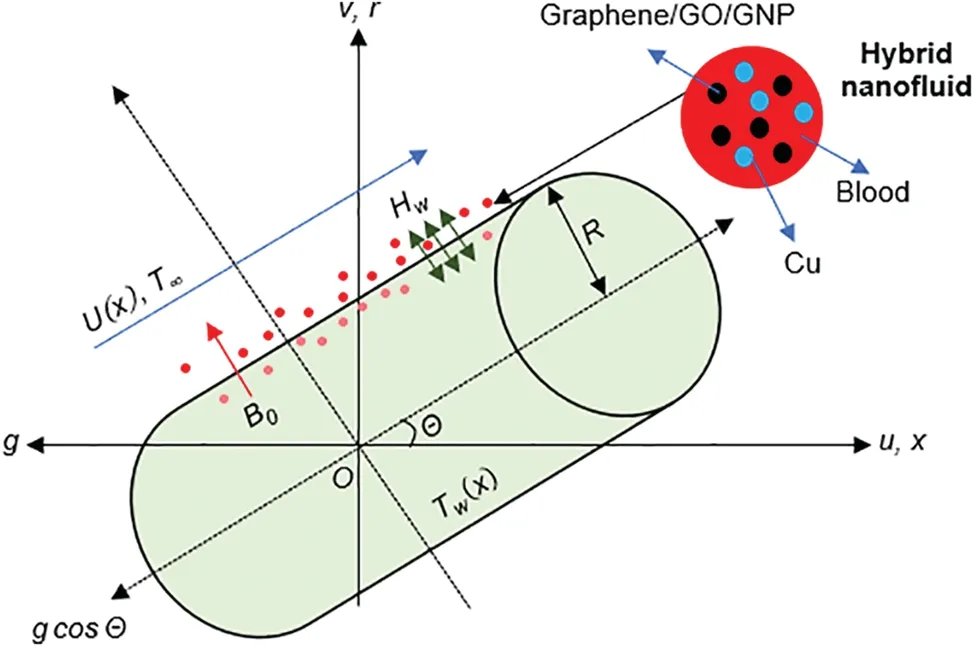
Figure 1:Schematic diagram of the flow with geometrical coordinates
The governed PDEs of continuity,momentum,and energy,as referenced in [15,18,29] with the corresponding boundary conditions(BCs),are given as:
For these,two cases of suction (Hw*<0) and injection (Hw*>0) are considered.Subsequent similarity transformations are presented as follows:
withψas the stream function,is characterized inu=r-1(∂ψ/∂r)andv=-r-1(∂ψ/∂r).
By substituting Eq.(9)into Eqs.(6)and(7),a dimensionless system of nonlinear ODEs is derived as below:
fandθare individual functions related to the dimensionless velocity and temperature profiles for the examined hybrid nanoliquids,and primes denote differentiation with respect toη.
The selected parameters used in this problem are defined mathematically as follows:
The skin friction,Cfand Nusselt number,Nuxare substantial quantities describing the fluid flow and are defined in[10].
whereτwandqware described as:
When Eq.(9)is substituted into Eq.(14),the resulting reduced skin friction and reduced Nusselt number are obtained:
3 Methods
In order to address the mathematical model for this problem,a robust solution technique is needed to ensure the accuracy and reliability of the outcomes of the controlling PDEs.Therefore,the numerical procedure for this non-Newtonian Sutterby hybrid nanoliquid flow of Cu-blood with chosen graphene,GO,or GNP over a slanted permeable cylinder is conducted using the bvp4c package in MATLAB.The bvp4c tool,derived from the finite difference technique,uses the collocation process in the Lobatto IIIa [32] formula.Additionally,the package implements a derivative scheme in the form off'based on the initial solution estimates and BCs[33].This approach offers a straightforward algorithm with reduced cost and high computational speed compared to other methods.Furthermore,many researchers have utilized this code,validating it as an effective solution for various mathematical and engineering challenges.
Given the variables:
a shooting approach is employed to reformulate the nonlinear Eqs.(10)and(11)with the BCs(13).The equations are decreased into the first-order DEs as follows:
Thus,the boundary conditions are defined as follows:
F(3)andF(5)are assumed to have initial values of 0 and the preferred limits forηrange from 0 to 10.In addition,the problem is also solved with a residual tolerance of 10-6.
4 Results and Discussion
The range of selected nanoparticles’volume fraction forφ1andφ2is from 0 to 0.04,which is simulated for the current problem.All calculations consider the specific shape factor of the nanoparticles,as listed in Table 2.Moreover,the Prandtl number,Pr=19.4049 [12] is utilized to represent the blood fluid.The distributions of velocity,temperature,reduced skin friction value,and reduced Nusselt number for various parameters,including curvature parameterγ,Sutterby fluid parameterζ,Hartmann numberM,mixed convectionλ,angle of inclinationΘ,thermal radiationRd,wall permeability parameterHwand local source of heating parameterQare presented in figures and tables for clarity.The applied range of parameter values is given in Table 3.
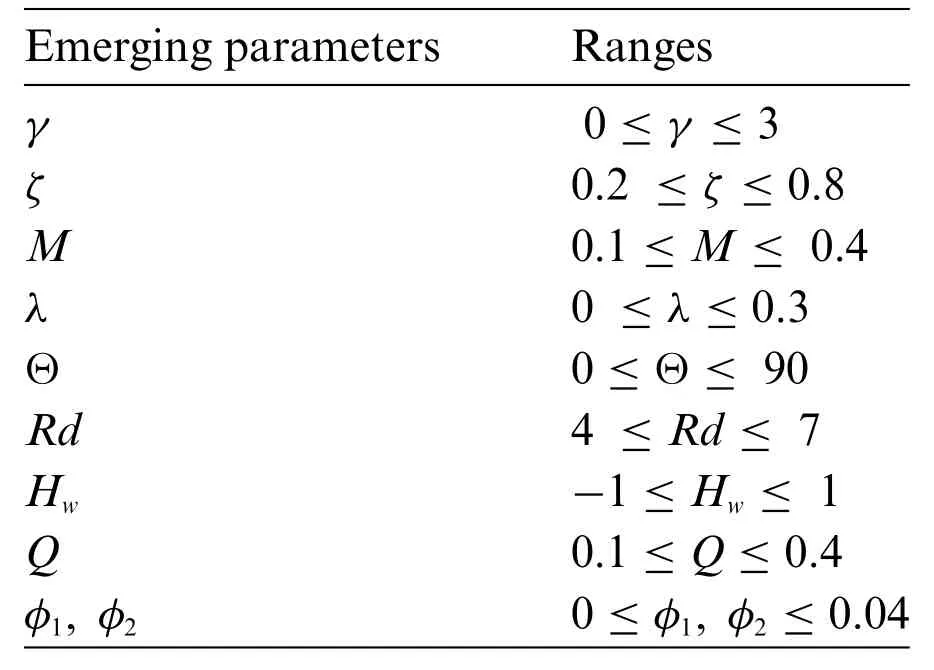
Table 3: The applied ranges of the emerging parameters for the current study
4.1 Validations
For the purpose of validation,the current results of the bvp4c code for Cu-water mono nanofluid are compared with the outcomes of previous work [18].The comparison in Table 4 supports the conclusions drawn from the present study.

Table 4:Comparison between present and previous[18]outcomes on the effects of λ and φ1 on Cuwater mono nanofluid when Pr=6.2,γ=1,φ2=0,M=0 and Hw=0

4.2 Velocity and Temperature Disseminations
In this section,the velocity and temperature distributions are thoroughly analyzed.Fig.2 illustrates the effects ofφ2on these distributions.The values ofφ2range from 0 to 0.04 for graphene,GO,and GNP and are combined with Cu (φ1=0.02)/blood to form hybrid nanofluids.Fig.2a indicates that velocity profiles decrease for all types of hybrid nanofluids with increasing values ofφ2.From the figure,Cu-blood mono nanofluids(φ2=0)demonstrate the highest velocity distribution compared to other hybrid nanofluids.Conversely,Fig.2b displays the rise in temperature distribution with increasingφ2.Cu-graphene/blood hybrid nanofluids exhibit the highest velocity but the lowest temperature distribution,while Cu-GNP/blood hybrid nanofluids present the opposite.Both graphene and GO nanoparticles are spherical (n=3),while GNPs are nanoplatelets (n=5.7) with a larger nanoparticle surface area than spheres.Greater nanoparticle volume fractions in hybrid blood flows(φ2≠0)and larger nanoparticle surface areas in contact with the cylindrical surface increase friction on the cylindrical surface.Consequently,velocities decrease,and temperatures rise in the nanofluid flows.This pattern can explain the observations in Fig.2.
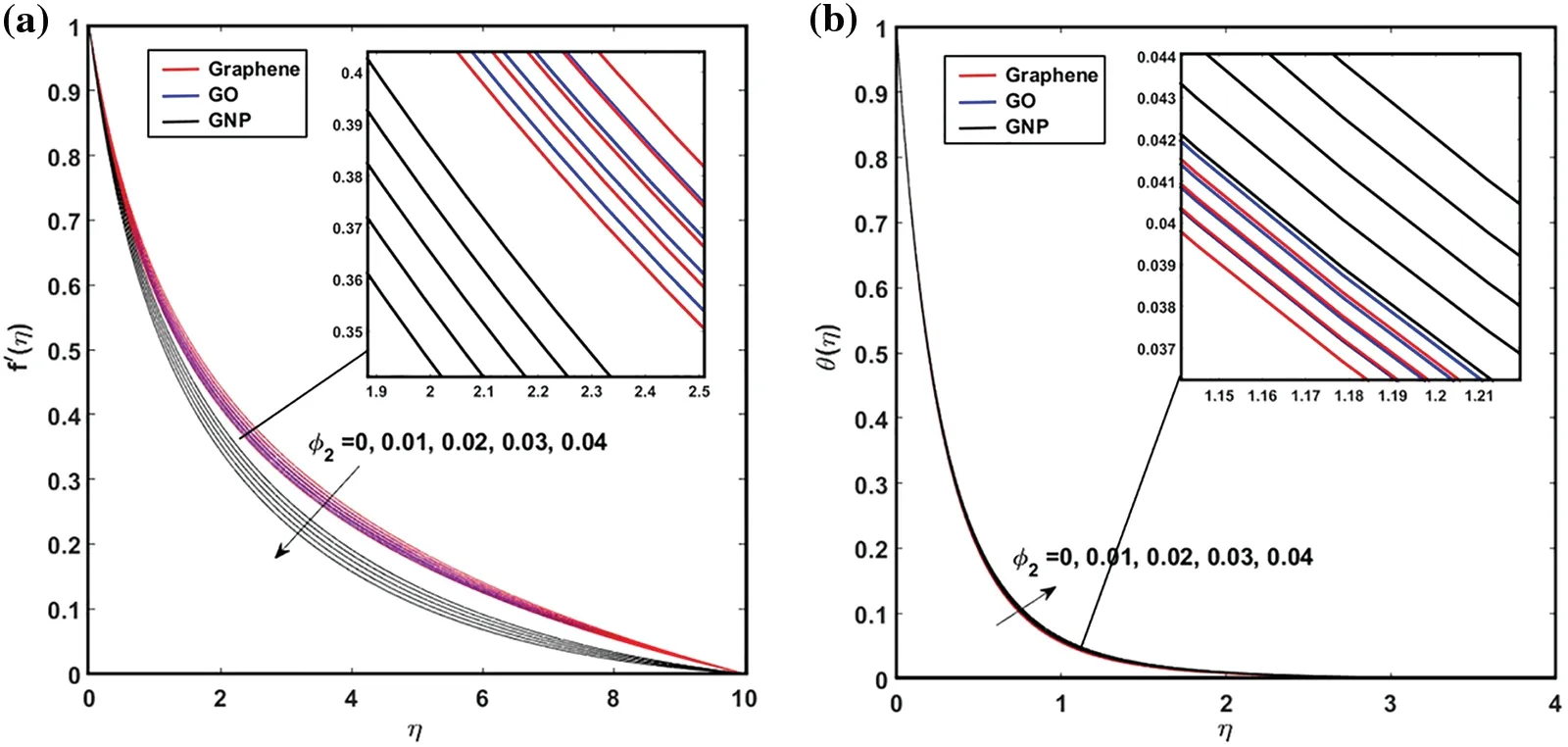
Figure 2:The repercussion of φ2 on(a)velocity and(b)temperature distributions
Fig.3 elucidates the effects ofΘon velocity and temperature distributions as inclination angles increase from 0°to 90°.Figs.3a and 3b indicate that the distributions reach their peak and trough atΘ=0°,respectively.In contrast,the distributions are at their minimum and maximum atΘ=65°,respectively.Cu-GO/blood hybrid nanofluid has the highest velocity distribution atΘ=0°,while Cu-GNP/blood hybrid nanofluid has the highest temperature distribution atΘ=65°.Conversely,the opposite effects are observed for velocity and temperature distributions of Cu-GO/blood hybrid nanofluid atΘ=65° andΘ=0°,respectively.Irregular patterns in flow velocity and temperature remain unclear.However,when the cylinder is inclined or vertical (Θ>0°),the flow direction is hindered by both gravity and surface friction,reducing velocity and increasing temperature due to added resistances to nanofluid movement.
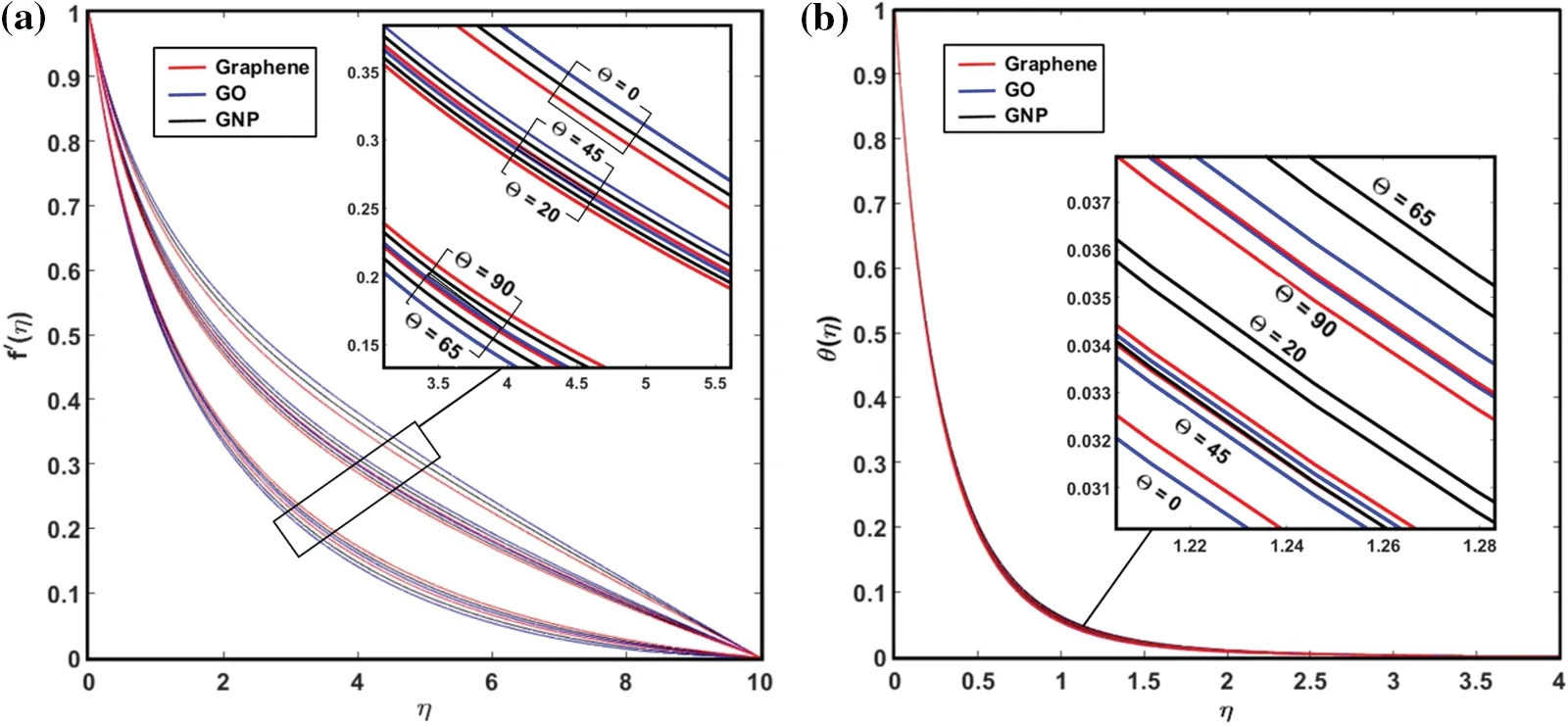
Figure 3:The repercussion of Θ on(a)velocity and(b)temperature distributions
Fig.4 illustrates the influences of γ,ζ,M,λandHwon the velocity distributions.Fig.4a depicts the velocity distribution increase for greater values ofγ.Asγincreases,the radius of the cylinder shortens,and consequently,the acceleration of the fluid flow intensifies due to the reduced flow resistance.Notably,the wall surface resembles a flat surface whenγ=0.According to Fig.4a,Cu-GO/blood hybrid nanofluids display the highest velocity distribution whenγranges from 0 to 3.Conversely,Fig.4b indicates that velocity decreases as values ofζincrease.The velocity distributions for Cu-GO/blood hybrid nanofluids peak when σ ranges from 0.2 to 0.8.Fig.4c reveals a speed inclination for higherMvalues ofM.The results show that Cu-GO/blood hybrid nanofluids achieve the highest velocity whenMranges from 0.1 to 0.4.This phenomenon results from the increase of the Lorentz drag force,which hinders the flow movement and increases the temperature of the nanofluids.
Alternatively,Figs.4d and 4e demonstrate that the velocity distributions decline as the values of the mixed convection parameter,λand the wall permeability parameter,Hw,increase.It indicates that all chosen hybrid nanofluids attain the highest velocity distributions atλ=0,while Cu-GO/blood hybrid nanofluid has the lowest velocity distribution atλ=0.3 (Fig.4d).Notably,the cylinder wall is impermeable whenHw=0,whereasHw>0 represents an injection case,andHw<0 corresponds to a suction case.In Fig.4e,Cu-GNP/blood hybrid nanofluid displays the lowest velocity profile forHw=1,while both Cu-GO/blood and Cu-graphene/blood hybrid nanofluids exhibit the highest velocity distributions atHw=-1.When the wall undergoes injection (Hw=1),it creates resistance and amplifies the opposing force in the flow direction.The increased nanoparticle surface area in contact with the cylindrical surface impedes the flow velocity distribution.From Fig.4,Cu-GO/blood and subsequently Cu-graphene/blood hybrid nanofluids consistently present the maximum velocity distributions.In contrast,Cu-GNP/blood hybrid nanofluid consistently has the minimum velocity distribution for allγ,ζ,M,andHwparameters,except for the λ parameter.
The influences ofγ,ζ,M,λ,Rd,Hw,andQon the temperature distribution are discussed in Fig.5.Figs.5a and 5b show the increase in temperature distributions with increasing values ofγfrom 0 to 3 andζfrom 0.2 to 0.8,respectively.The temperature distribution is lowest for all selected hybrid nanofluids whenγ=0,but the Cu-GNP/blood hybrid nanofluid exhibits the highest temperature distribution whenγ=3,as seen in Fig.5a.Fig.5b reveals that Cu-GNP/blood hybrid nanofluids possess the highest temperature distribution,while Cu-GO/blood hybrid nanofluids have the lowest for all values ofζused in this study.In addition,Fig.5c demonstrates a decline in temperature distributions with increasing values ofMfrom 0.1 to 0.4.It also emphasizes that Cu-GNP/blood hybrid nanofluids consistently maintain the highest temperature distribution.In contrast,Cu-GO/blood hybrid nanofluids are at the lowest for all examined values ofM.Fig.5d highlights an incline in temperature distributions asλincreases from 0 to 0.3.All chosen hybrid nanofluids have their lowest temperature distribution atλ=0,while Cu-GO/blood hybrid nanofluids attain the highest velocity temperature atλ=0.3.The velocity distribution also increases,as shown in Fig.5e,with greater values ofRd.The thermal gradient rises,and the mean absorption coefficient decreases with increasingRd.As a result,the temperature distribution elevates with higher levels of thermal radiation.Fig.5e shows that Cu-GNP/blood hybrid nanofluids lead in temperature distribution,followed by Cu-graphene/blood and Cu-GO/blood hybrid nanofluids for allRdvalues ranging from 4 to 7.Furthermore,Fig.5f illustrates a decrease in temperature distribution asHwvalues rise from-1 to 1.However,a consistent observation from this figure is that Cu-GNP/blood hybrid nanofluids still have the highest temperature distribution,followed by Cu-graphene/blood and Cu-GO/blood hybrid nanofluids for allHwvalues.Fig.5f demonstrates an increase in temperature distribution for risingQvalues from 0.1 to 0.4 across all hybrid nanofluids.In summarizing the results from Fig.5,Cu-GNP/blood hybrid nanofluids consistently have the highest temperature distribution,followed by Cu-graphene/blood and Cu-GO/blood hybrid nanofluids for the γ,ζ,M,Rd,Hw,”andQparameters,except in the case of the mixed convection parameter,λ.
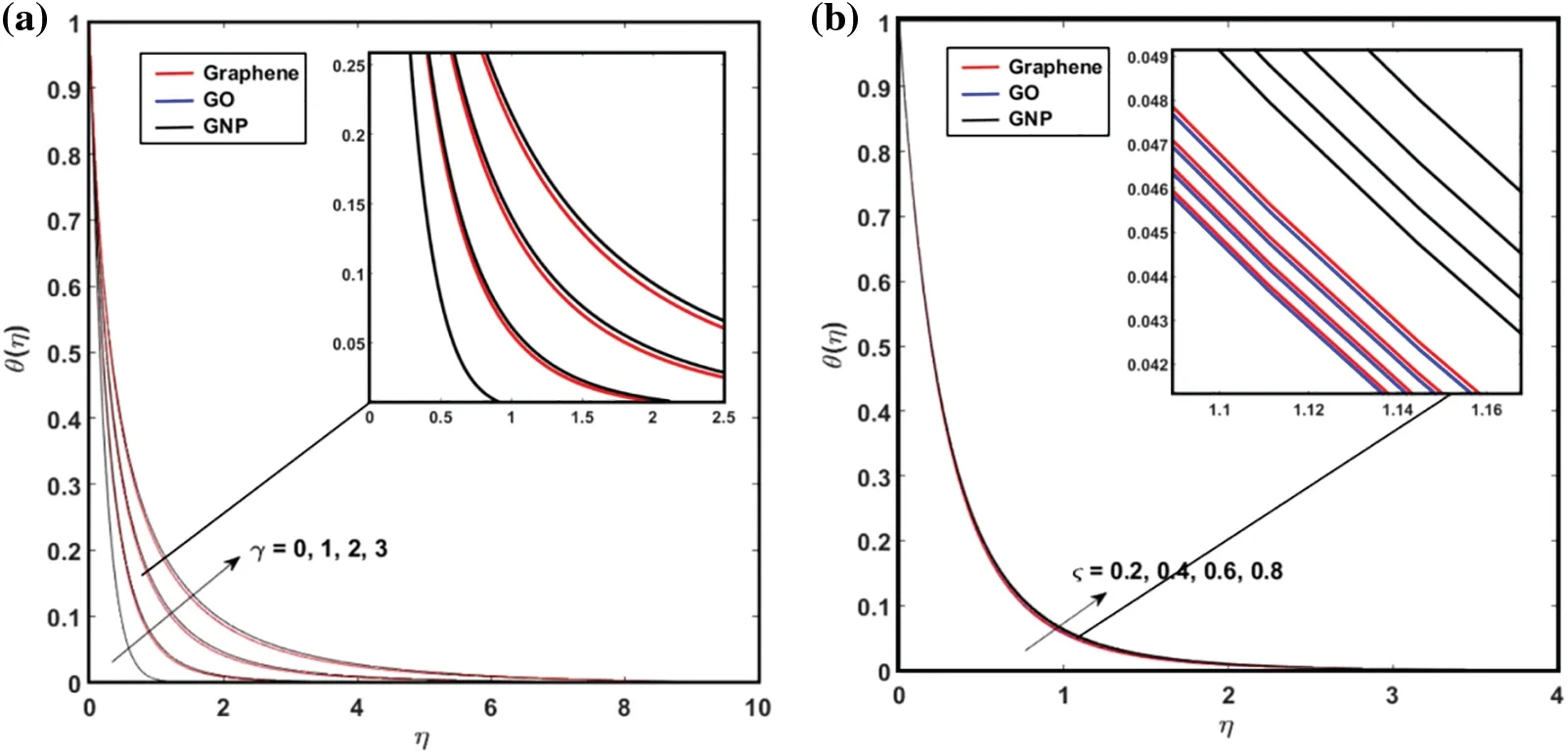
Figure 5: (Continued)
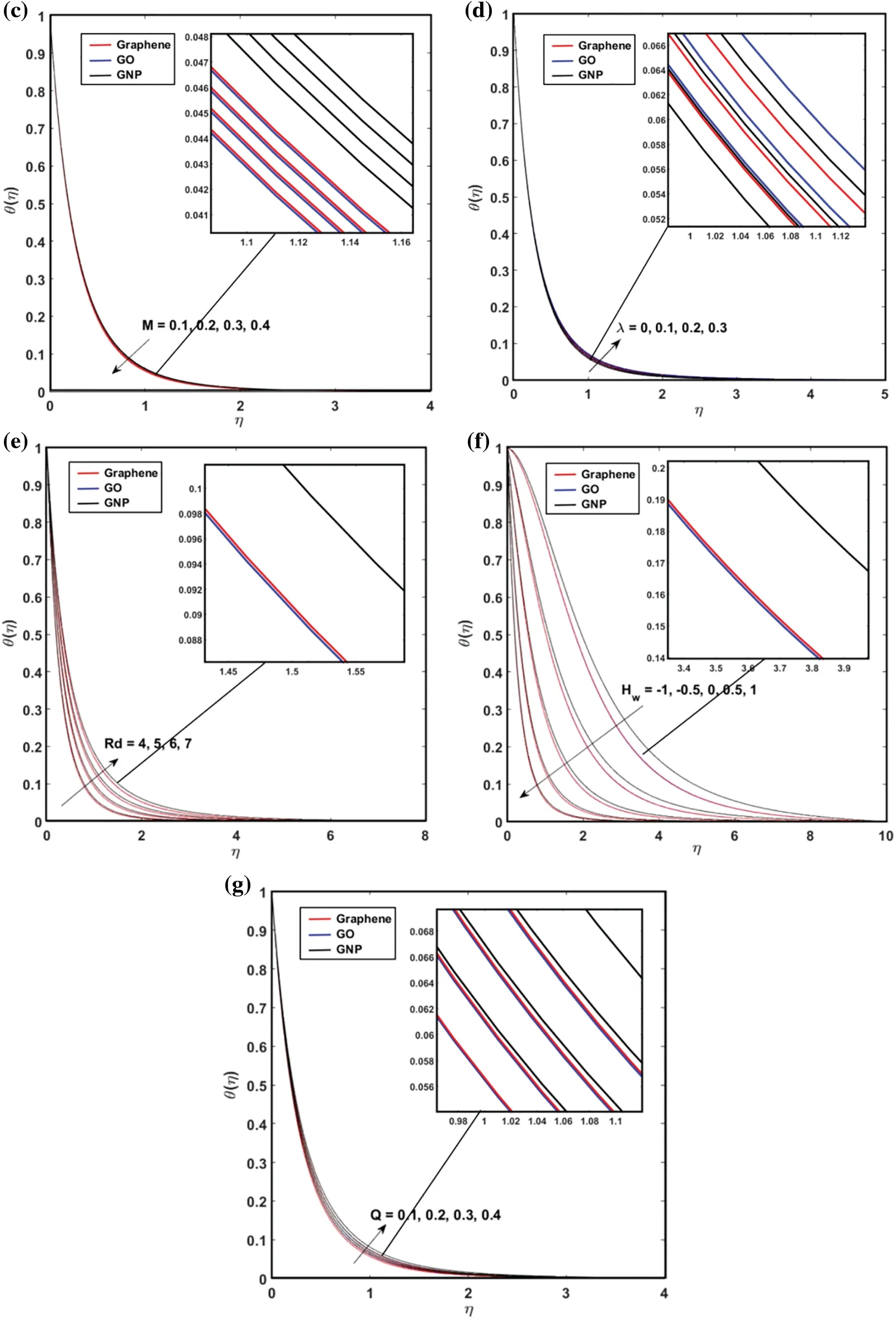
Figure 5: The repercussion of (a) γ,(b) ζ,(c) M,(d) λ,(e) Rd,(f) Hw and (g) Q on temperature distributions
4.3 Reduced Skin Friction Value and Reduced Nusselt Number
This section particularly interprets and explains the outcomes of reduced skin friction value and reduced Nusselt number.It is important to note that negative signs for the values of reduced skin friction generated from this present study represent the magnitude in which it shows the friction is opposite to the direction of the flow.The impacts ofΘon the two quantities are presented in Table 5.The values ofΘfrom 0° to 90° are implemented in the present study in which the value ofΘ=0° indicates that the cylinder is at the horizontal position while the value ofΘ=90° indicates that the cylinder is at the vertical position.Table 5 shows that the reduced skin friction value and the reduced Nusselt number in consideration of all types of hybrid nanofluids decrease irregularly with increasing angles ofΘ.However,it is noticeable that the magnitude of the reduced skin friction values is at the lowest and greatest values whenΘ=0°andΘ=65°,respectively,for all selected hybrid nanofluids.In addition,the table shows that Cu-GO/blood hybrid nanofluids(CfRe1/2=1.06396)have the greatest magnitude of reduced skin friction,followed by Cu-GNP/blood(CfRe1/2=1.05484)and Cu-graphene/blood (CfRe1/2=1.03985) hybrid nanofluids atΘ=65.It is also notable to observe that the reduced Nusselt numbers are at the highest and lowest values whenΘ=0°andΘ=65°,respectively,for all selected hybrid nanofluids.It can be clearly noticed that Cu-GNP/blood hybrid nanofluids(NuxRe-1/2=23.02017)have the greatest reduced skin friction,followed by Cu-GO/blood(NuxRe-1/2=21.72835)and Cu-graphene/blood(NuxRe-1/2=21.72805)hybrid nanofluids atΘ=0°.

Table 5: The repercussion of Θ on reduced skin friction value and reduced Nusselt number
The impact of value variations ofφ1andφ2against the reduced skin friction value and the reduced Nusselt number are anticipated in Table 6.The values imposed onφ1andφ2are from 0.01 to 0.04.NF-A mono nanofluid represents the Cu/blood mono nanofluid with different values ofφ1while NF-B,NF-C,and NF-D mono nanofluids represent the graphene/blood,GO/blood,and GNP/blood mono nanofluids with different values ofφ2,respectively.Moreover,HNF-AB,HNF-AC,and HNFAD hybrid nanofluids represent the Cu-graphene/blood,Cu-GO/blood,and Cu-GNP/blood hybrid nanofluids whenφ1=φ2.In addition,HNF-AB1 until HNF-AB4,HNF-AC1 until HNF-AC4,and HNF-AD1 until HNF-AD4 are hybrid nanofluids that represent the Cu-graphene/blood,Cu-GO/blood,and Cu-GNP/blood hybrid nanofluids whenφ1=0.02 and 0.01 ≤φ2≤0.04.Table 6 indicates that the reduced skin friction values incline for higher counts ofφ1andφ2based on selected types of mono and hybrid nanofluids.These results further exhibit that the reduced Nusselt number increases with growing values ofφ2for all mono and hybrid nanofluids except for NF-A(Cu/blood mono nanofluids).In addition,the result shows that NF-D (GNP/blood mono nanofluids) withφ2=0.04 has the highest magnitude of reduced skin friction and Nusselt number compared to other mono nanofluids types.Furthermore,the outcome exhibits that HNF-AD (Cu-GNP/blood hybrid nanofluids) has the highest Nusselt number compared to HNF-AB and HNF-AC whenφ1=φ2are applied.Next,HNF-AD4 (Cu-GNP/blood hybrid nanofluids withφ1=0.02 andφ2=0.04) has the highest Nusselt number compared to other types of hybrid nanofluids.Thus,from the table data,it can be indicated that GNP nanoparticles withn=5.7 enhance the heat transfer performance of Cu-GNP/blood hybrid nanofluid because of its’nanoplatelet shape that allows bigger nanoparticle surface area in contact with the cylindrical surface as compared to the spherical graphene and GO shapes.

Table 6: The repercussion of φ1 and φ2 on reduced skin friction and Nusselt number

Table 7 displays the impacts of the parameters ofγ,ζ,M,λ,Rd,HwandQon the reduced skin friction value and on the reduced Nusselt number whenφ1=0.02 (for Cu) andφ2=0.03 (for graphene,GO,or GNP)are applied to the current model.Initially,the study assumesγ=1,ζ=0.4,M=0.1,λ=0.1,Θ=90,Rd=4,Hw=1,andQ=0.1 as the default values for these parameters.From Table 7,both reduced quantities decrease with higher values ofγ,while an increase is observed with higher values ofHw.Conversely,the magnitudes of reduced skin friction and reduced Nusselt number increase and decrease with rising values ofζandλ,respectively.However,the inverse is true for elevated values ofM.Increases inRdandQappear not to influence the reduced skin friction values but they decrease the reduced Nusselt number in both instances.Notably,Cu-GNP/blood hybrid nanofluids exhibit the highest reduced skin friction coefficient compared to other chosen hybrid nanofluids for all parameters except theλparameter.Furthermore,possessing the highest reduced Nusselt number for all parameters,Cu-GNP/blood hybrid nanofluids act as the superior heat flux conductor among other hybrid nanofluids used in this research.
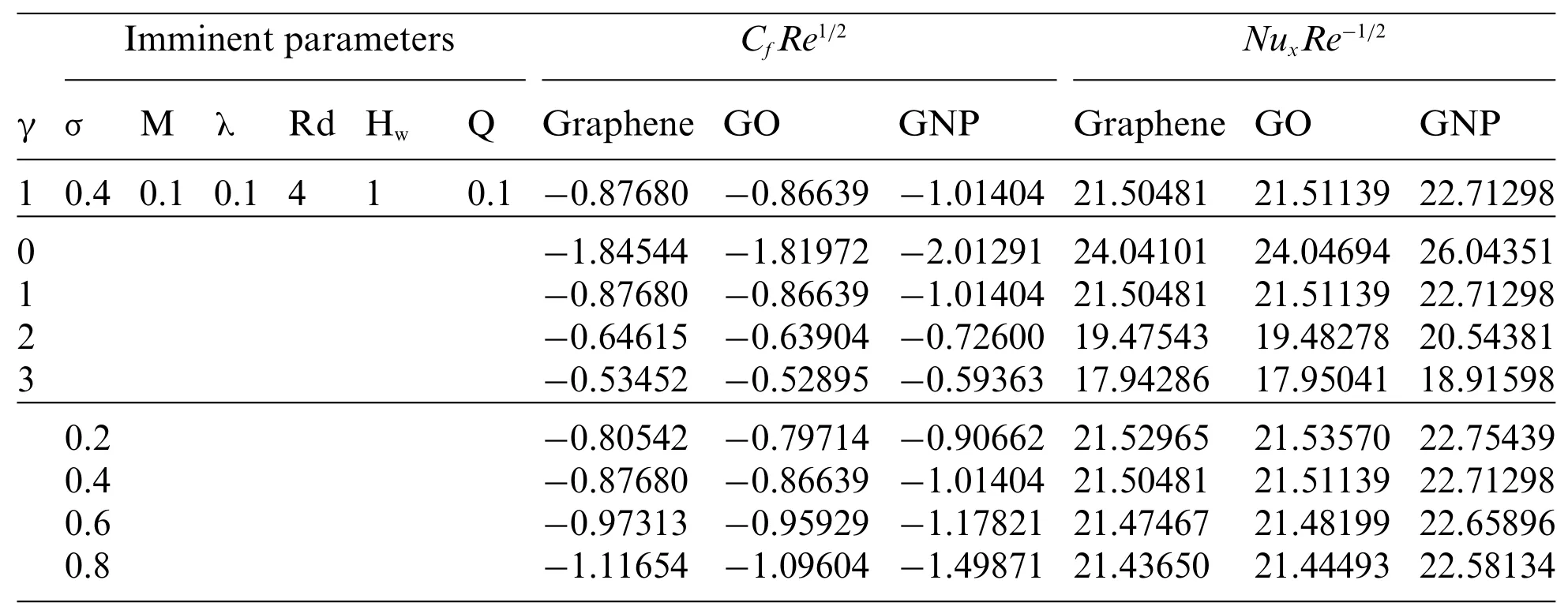
Table 7:The repercussion of some imminent parameters on reduced skin friction and Nusselt number when φ1=0.02 and φ2=0.03(for graphene,GO and GNP)
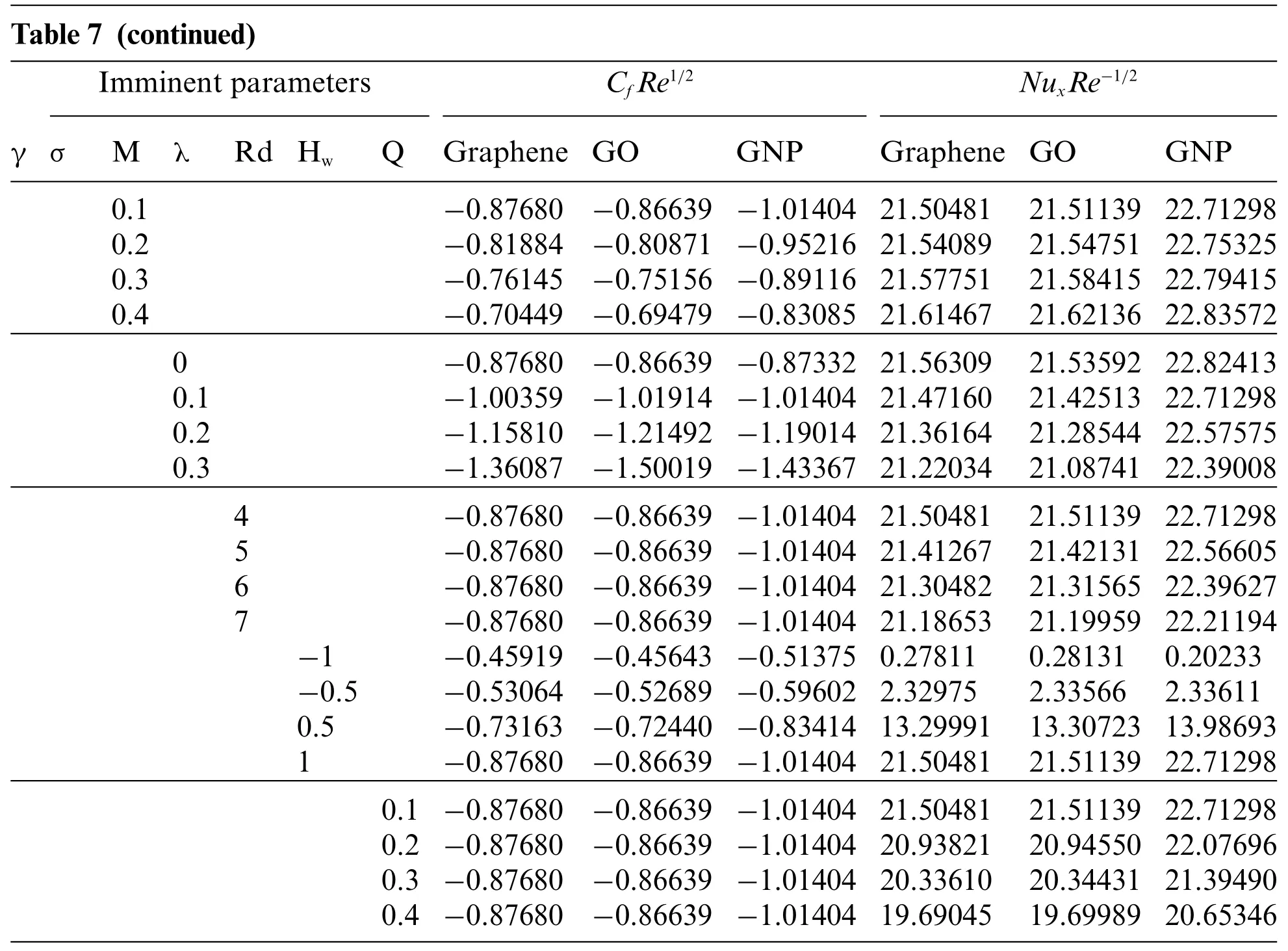
5 Conclusion
This study examines the effects of thermal radiation and heating sources on non-Newtonian Sutterby hybrid nanofluids consisting of various types of graphene,GO,and GNP with Cu-blood over a slanted permeable cylinder.Initially,the governing PDEs of the fluid model are transformed into nonlinear ordinary DEs using analogous transformational terms.Subsequently,they are addressed with the bvp4c scheme in MATLAB to obtain numerical solutions.The effects of other pertinent parameters on the Sutterby non-Newtonian blood nanofluids are also assessed and presented in figures and tables.The results are as follows:
· The velocity distributions increase with increasing values ofγandM,but decrease for higher values ofφ2,ζ,λandHw.
· The temperature distributions rise for greater values ofφ2,γ,ζ,λ,RdandQ,but diminish for higherMandHw.
· Cu-graphene/blood hybrid nanofluids exhibit the highest velocity but the lowest temperature distribution,while Cu-GNP/blood hybrid nanofluids show the lowest velocity and the highest temperature distributions for all values ofφ2.
· Cu-GO/blood hybrid nanofluids have the greatest velocity distributions,followed by Cugraphene/blood hybrid nanofluids,while Cu-GNP/blood hybrid nanofluids display the lowest velocity distribution for all values of γ,ζ,MandHwparameters except for theλparameter.
· Cu-GNP/blood hybrid nanofluids possess the maximum temperature distribution,followed by Cu-graphene/blood and Cu-GO/blood hybrid nanofluids for γ,ζ,M,Rd,Hw,andQparameters,except in the case of theλparameter.
· The magnitude of the reduced skin friction values is at its minimum and maximum whenΘ=0°andΘ=65°,while the opposing results of the reduced Nusselt number are observed atΘ=0°andΘ=65°for all hybrid nanofluids used in this study.
· Both magnitude quantities of reduced skin friction and reduced Nusselt number increase for greater values ofφ2.However,the reduced Nusselt number decreases for a greater copper nanoparticle volume fraction,φ1.
· HNF-AD4(Cu-GNP/blood hybrid nanofluid withφ1=0.02 andφ2=0.04)boasts the highest Nusselt number compared to other types of hybrid nanofluids.
· Thus,GNPs(with the nanoplatelet shape factorn=5.7)are highly recommended to enhance the heat transfer performance of blood-based hybrid nanofluids as they contribute approximately 5% on average and up to 7.8% higher reduced Nusselt number compared to other nanoparticles of graphene and GO.
· The reduced skin friction value rises with higher values ofζ,λandHw,but decreases for higher values of γ andM.
· The reduced Nusselt number increases for increasing values ofMandHw,but decreases for higher values of γ,ζ,λ,RdandQ.
Several potential applications arise from these research findings.For example,guidance for evaluating occupational and public health risks related to radiation and electromagnetic field exposure can be based on blood studies in rats.Moreover,the nanoparticles selected for this study can be particularly effective in medical treatments such as cancer therapy,anti-infection measures,and drug delivery.Hence,they promise to enhance medical systems,equipment,and devices.Nevertheless,further research in this domain must address the study’s limitations and comprehensively meet industrial objectives and practical requirements.
Acknowledgement:Authors highly appreciate the contributions made by reviewers towards the final improvement of this manuscript.
Funding Statement:This research is funded by the Ministry of Higher Education,Malaysia,through the Research Fund of Fundamental Research Grant Scheme(FRGS/1/2020/STG06/UM/02/1:FP009-2020).
Author Contributions:Conceptualization,N.F.M.N.;methodology,S.N.A.G.;validation,S.N.A.G.;formal analysis,S.N.A.G.;investigation,S.N.A.G.and N.F.M.N.;data curation,S.N.A.G.;writing—original draft preparation,S.N.A.G.;writing—review and editing,N.F.M.N.;visualization,S.N.A.G.;supervision,N.F.M.N.;project administration,N.F.M.N.;funding acquisition,N.F.M.N.All authors have read and consented the finalized version of the manuscript.
Availability of Data and Materials:The present study utilizes data simulation with the numerical results as presently calculated.
Conflicts of Interest:The authors declare that they have no conflicts of interest to report regarding the present study.
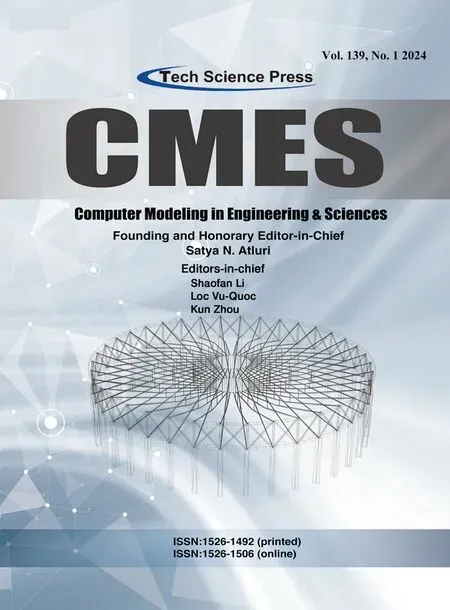 Computer Modeling In Engineering&Sciences2024年4期
Computer Modeling In Engineering&Sciences2024年4期
- Computer Modeling In Engineering&Sciences的其它文章
- An Efficient Local Radial Basis Function Method for Image Segmentation Based on the Chan-Vese Model
- Optimization Algorithms of PERT/CPM Network Diagrams in Linear Diophantine Fuzzy Environment
- A Comparative Study of Metaheuristic Optimization Algorithms for Solving Real-World Engineering Design Problems
- Crashworthiness Design and Multi-Objective Optimization of Bionic Thin-Walled Hybrid Tube Structures
- Enhancing Healthcare Data Security and Disease Detection Using Crossover-Based Multilayer Perceptron in Smart Healthcare Systems
- Parametric Optimization of Wheel Spoke Structure for Drag Reduction of an Ahmed Body
